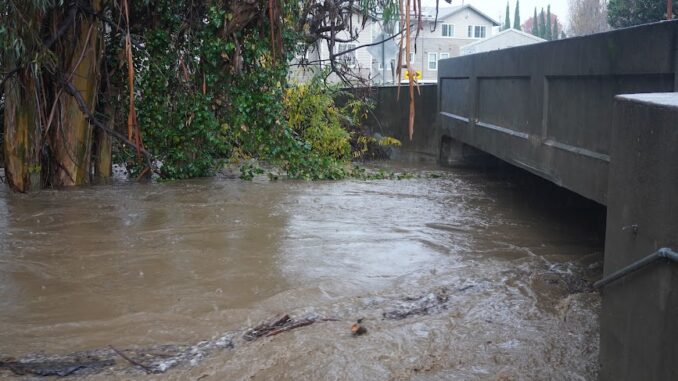
This story was originally printed in the Daily Post on Thursday morning. Get in the habit of picking up the Post in the mornings for important local news stories.
BY BRADEN CARTWRIGHT
Daily Post Staff Writer
A tangled web of government agencies, regulations, funding disagreements and lawsuits have delayed the replacement of two bridges over San Francisquito Creek for 25 years and counting, so residents in the area face the same flood threat today as in February 1998, when thousands of homes were inundated with water after days of rain.
Even before the flood in 1998, people knew that the Pope-Chaucer Bridge and the Newell Bridge were chokepoints that made it so the creek couldn’t hold all of the water in a major flood.
A year after the chokepoints led to disaster, water districts in San Mateo County and Santa Clara County teamed up with the cities of Menlo Park, Palo Alto and East Palo Alto to form an agency called the San Francisquito Creek Joint Powers Authority, which is dedicated to reducing flooding.
East Palo Alto Councilman Ruben Abrica has been working on the creek authority since the flood. He said in a November interview that the bridge should’ve been replaced by the federal government because local governments don’t have the money.
The creek authority has to go through regulatory processes with at least six different agencies, each with their own priorities, Abrica said. Some agencies are concerned with the Clean Water Act, while another might be looking at the Endangered Species Act.
“It’s a fragmented system,” Abrica said.
Permitting also slows things down. The Regional Water Quality Control Board took over two years to approve a single permit.
Construction can only be done during the dry season, which lasts from around May to October each year.
Engineers have insisted that the creek authority do flood control projects downstream first. If not, then construction would transfer flood risk elsewhere rather than solving the problem.
That means projects have had to go in order. The first major project was finished in 2019 in East Palo Alto: Large steel levees were put into the ground, and the floodplain was widened to 200 feet, protecting 1,700 homes from flooding east of Highway 101.
The project had been the creek authority’s focus since 2009.
Instead of immediately replacing the bridges after the 1998 flood, the cities of Palo Alto and Menlo Park paid $3.5 million in 2004 to settle a lawsuit from 27 families who were impacted. The settlements didn’t require the cities to work on either of the bridges.
For years, the creek authority looked toward the U.S. Army Corps of Engineers to fix the problem. The Army Corps did a study and gave the authority some money, but funding was cut off after Hurricane Katrina as Congress focused on areas that had a greater economic interest, Abrica said.
The city of Palo Alto, not the creek authority, is replacing the 118-year-old Newell Bridge. Council initially approved the project in 2011, but neighbors have opposed it every step of the way over fears that a wider bridge will increase traffic in their neighborhood.
The city explored putting up walls along the creek but many neighbors were against that idea too. Meanwhile, the creek flooded again in 2012.
Yang Shen, a homeowner who lives next to the bridge at 1499 Edgewood Drive, sued in 2020 after the city completed an environmental review. He said the review didn’t address how his property would be impacted by construction, and it should’ve looked at removing the bridge and not replacing it.
Menlo Park resident Peter Joshua filed a lawsuit on similar claims against the creek authority relating to the Pope-Chaucer Bridge.
An appellate court ruled against Joshua in August, and Shen agreed to drop his lawsuit a month later.
The Newell Bridge is scheduled to be replaced starting in the spring, with construction taking about a year and a half.
And finally, the Pope-Chaucer bridge would be replaced by the creek authority in 2025.

A few points: Wasn’t Newell bridge built in 2010 or so? It’s less than 118 years old I think. It doesn’t flood like the University Avenue bridge does. The downstream improvements are great, this week would’ve been a disaster without them.
The city’s website says the bridge was built in 1911. I’ll do the math for you. It’s 112 years old.
Thanks, it was a typo – I meant 1910.
The opinions of a few control the fate of the many. We allow too many activists to speak out and stop things that would benefit the entire community, like replacing these bridges.
Protect endangered species and clean water? The nerve of those federal agencies. Surely city councils (many, many bearing only high school diplomas) know better.
How about if the neighbors who got flooded last week file a lawsuit against the neighbors who opposed the bridge replacement? Just an idea..